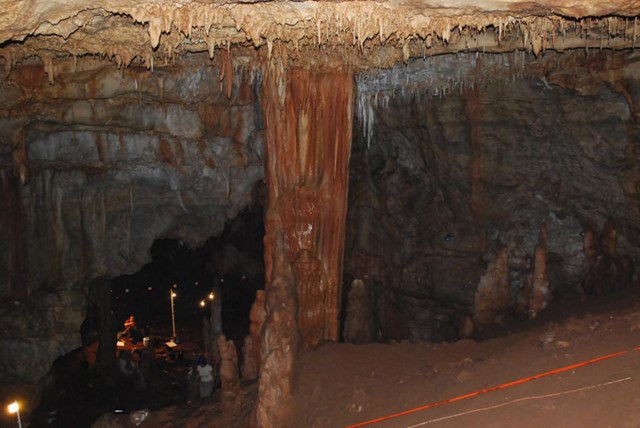
Manot Cave in northern Israel.
Archaeologists have discovered that prehistoric tools and artwork from western Europe owe their existence to an even earlier culture in the Middle East. Carbon dating of a cave in Israel supports a theory that the Ahmarian culture of the Levant predated the Aurignacian culture of Europe by thousands of years, according to Haaretz.
The Ahmarian and Aurignacian cultures were the first two modern human cultures, according to Haaretz. They did coexist, but it’s been unclear if one was borne from the other. Now, archaeologists have dated the Ahmarian-inhabited Manot Cave, in northern Israel near the Lebanon border, which shows that Ahmarians lived in the region around 42,000 to 46,000 years ago—earlier than Aurignacians are known to exist.
This evidence suggests that somewhere around that time the Ahmarians entered Europe and gave rise to the entire Aurignacian culture—evolving along the way—and it weakens the opposing theory that the two cultures evolved at the same time and independently of each other.
“Once we see a sequence from the Levant to Europe, from the older to the younger, we can confirm that the dispersal model of the Ahmarian-Aurignacian is right,” co-lead excavator Omry Barzilai, an archaeologist with the Israel Antiquities Authority, told Haaretz. “If in the Levant this culture is 46,000 years old and in Europe it’s 40,000 then it makes sense to say that the direction is from the Levant to Europe.”
Scientists from the Dangoor Research Accelerator Mass Spectrometry Laboratory at the Weizmann Institute in Rehovot, Israel, were able to radiocarbon date the charcoal remains from Manot Cave’s hearths. Elisabetta Boaretto, director of Weizmann’s Kimmel Center for Archaeological Science, told Haaretz that they were able to date levels containing tools from each culture. The Middle Eastern Ahmarians developed predominantly stone tools, while the later European Aurignacians developed bone tools.
In early 2017, a paper in the scientific journal Quaternary International published details of a 38,000-year-old Aurignacian engraved image in France. The culture is known for its artwork, including cave paintings and elaborately carved jewelry, Barzilai told Haaretz.
Barzilai is also one of the authors of a paper published in November in the journal Science Advances demonstrating that while the diaspora throughout Europe was unfolding, it didn’t remain a one-way trip for all the Aurignacians. Around 38,000 years ago, some of them went back to the Middle East, reoccupying Manot Cave and others like it, possibly pushed by changing temperatures in the ice age.
“Think of it like this: they went to northern Europe, made a U-turn and came back,” Barzilai told Haaretz.
According to the Science Advances paper, there are four additional sites besides Manot that have similar sequences of radiocarbon dates—three rock shelters on the Mediterranean coast and one in the Jordan Valley. No prehistoric cave-painting sites have been found in regions inhabited by Ahmarians; all known examples are in Europe and are associated with Aurignacians, Haaretz reported.
